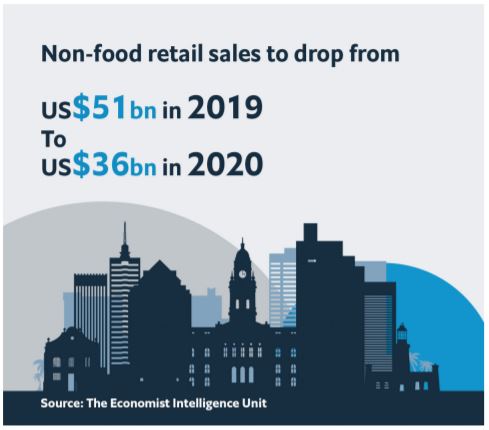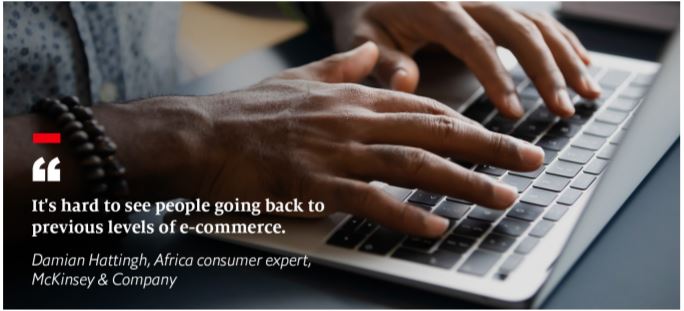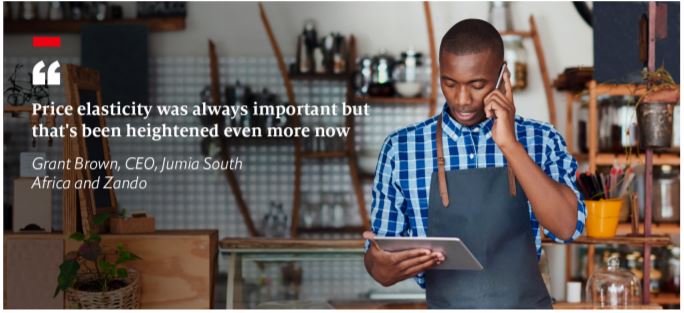When South Africa entered one of the world’s strictest lockdowns on March 27th, its economy was already in recession and unemployment stood at 30%.1 In a bid to curb the spread of coronavirus among the country’s 60m people,2 the government banned sales of all but essential items—mainly food, medicine and hygiene products—until early May.
“We’ve seen consumers—who were in a state of economic crisis even before the pandemic hit—take a real knock as the lockdown kicked in,” says Damian Hattingh, Africa consumer expert at McKinsey & Company, a consultancy. Although the South African government has implemented measures to protect people’s livelihoods (such as the US$28bn package that includes social grants and unemployment insurance), its resources are limited compared with more developed countries. In addition, the 2.9m people working in the informal sector have little or no income protection and are highly vulnerable to income shocks.3
This, together with pandemic-related restrictions, triggered a fall in consumer spending. South African retail trade sales fell by 22.8% in the second quarter of 2020 compared with the same period of 2019.4 In June, all sectors recorded lower sales year on year with the exception of hardware, household furniture, appliances and equipment. The Economist Intelligence Unit (EIU) forecasts retail sales of non-food items to drop to US$36bn in 2020 from US$51bn last year.
 The forecast factors in the sharp decline in consumer confidence. The FNB/BER Consumer Confidence Index for South Africa plunged from -9 in the first quarter of 2020 to -33 in the second quarter.5 “Just the fear of losing income created major spending changes,” says Mr Hattingh. People’s concerns over safety and hygiene in public spaces have also contributed to the shift in consumer spending patterns.
The forecast factors in the sharp decline in consumer confidence. The FNB/BER Consumer Confidence Index for South Africa plunged from -9 in the first quarter of 2020 to -33 in the second quarter.5 “Just the fear of losing income created major spending changes,” says Mr Hattingh. People’s concerns over safety and hygiene in public spaces have also contributed to the shift in consumer spending patterns.
These changes have manifested in a preference for local stores and online shopping, a shift in brand selection and increased price sensitivity.
Closer to home
South African consumers were quick to switch stores during the pandemic. A McKinsey consumer survey carried out in June reveals that over a quarter of respondents (27%) changed their primary grocery store and more than half of these say they intend to stick with the switch.6
Wary of travelling to large shopping centres and spending a lot of time in public spaces, consumers switched to local stores, many of them informal, family-run shops or chains with more convenient locations. This is a big change, explains Mr Hattingh, given that “going to the big shopping malls was a classic pastime for South African consumers, something of a family day out”.
At the product level, a brand shift was most apparent for tobacco items. Following the ban on alcohol and tobacco sales as part of pandemic-related restrictions, illegal sales soared. A survey of more than 23,000 people conducted in June by the University of Cape Town (UCT) shows that despite a sharp rise in cigarette prices (by 250% on average) a majority of smokers continued to buy tobacco from friends and family (27%), informal convenience shops, known as spazas (25%), street vendors (11%) and WhatsApp groups (8%).7
As a result, many consumers said that they had been forced to shift from international brands to local ones. International brands previously dominated the market but their share of total sales decreased to less than 20% among those surveyed.8 “The tobacco sales ban during the lockdown has thrown the cigarette market into disarray. The market has completely changed,” said Corné van Walbeek, director of the Research Unit on the Economics of Excisable Products at UCT, when the research was released in July.9
Similarly, the ban on alcohol sales resulted in an increase in illicit sales10—with restaurants offering red or white “coffee”—as well as the sale of pineapples for home brewing,11 according to some reports.
The bans on alcohol and tobacco sales were lifted in August. The extent to which consumers switch back to international brands may be indicative of broader consumer trends and preferences in South Africa.
An e-commerce surge
Another shift in consumer behaviour was a move to online shopping. E-commerce platform, Jumia, has seen a rise in customer numbers and sales of essential items on its South African platform since the lockdown began.
Government restrictions in the first few weeks of lockdown meant that Jumia’s online fashion business, Zando, could not operate and that its general shopping platform was restricted to sales of essential goods. So Jumia—which had completed a soft launch of its website in South Africa just months before lockdown began— created an essential-goods platform selling dry foods and personal care and hygiene products.12 It formed partnerships with big brands in those categories, such as Unilever and Reckitt Benckiser, to ensure a steady supply of products.
When restrictions eased in May, Zando saw a surge in sales, says Grant Brown, CEO of Jumia South Africa and of Zando. But the composition of sales did not reflect pre-pandemic trends. One of Zando’s previously top-selling categories did not take off.

As people were confined to their homes, “we’ve seen quite a drop-off in high heels,” says Mr Brown. On the other hand, the company’s essential goods and bedding products performed better than their pre-Covid levels.
There is a real chance that the lockdown will become an inflection point for growth in e-commerce, says Mr Hattingh. In a series of McKinsey surveys on how South African consumer behaviour is changing amid Covid-19, respondents stated that they intend to increase online shopping for both grocery and non-grocery items even after the pandemic has subsided. “It’s hard to see people going back to previous levels of e-commerce,” he says.
Mr Brown concurs, particularly with regard to fast-moving consumer goods. Whereas previously people may have used online shopping for infrequent purchases like electronics, “high-frequency purchases are now going to be a little bit more sustainable going forward, and ingrained,” he says.
These trends are clearer among urban consumers: 70% of Jumia’s orders come from Johannesburg, Cape Town and Durban. In rural areas, people’s lower levels of smartphone ownership—as well as differences in their shopping behaviour, such as a preference for cash-based purchases—have limited the company’s reach, explains Mr Brown (cash on delivery was not available since the start of the pandemic due to restrictions).
Building boom
The lockdown triggered a building boom in South Africa’s rural areas that took builders’ merchants by surprise. People living in South Africa’s hinterlands, and those migrating from cities back to their rural bases, began building or expanding their homes when restrictions eased in May, says Rob Lister, managing director of Build it,13 a chain of builders’ merchants and a division of retail company SPAR.
Rural residents have no fixed overheads, so they tend to put any windfall—such as recent redundancy payments—into building, explains Mr Lister. A lack of planning regulations has meant that people could build straight away.
As a result, Build it’s year-on-year growth stood at 15% in May, 18% in June and 25% in July. By comparison, sales were down by 2-3% year on year in the same months in 2019. “The turnaround from the period of being totally closed for six weeks has been nothing short of phenomenal,” says Mr Lister.
Although 80% of Build it’s 400 stores are in rural areas, its urban stores have also done well. “With people being quarantined at home, they’ve applied their minds to what they would [like] to have done,” he says.
Build it saw customers migrate from small builders’ merchants to the chain’s larger stores, partly because smaller traders had difficulty sourcing building materials during the pandemic. Personal safety is another factor in their choice of store, says Mr Lister. Build it’s stores are sanitised every night and all customers and staff follow the health protocols.
The breaking price point
During this period of macroeconomic uncertainty, retailers have had to pay close attention to pricing strategies. “Price elasticity was always important but that’s been heightened even more now,” says Jumia’s Mr Brown. Even a slight change in price has a large impact on sales volume.

Mr Brown points to more evidence of this price sensitivity. Although basket sizes have remained similar to pre-pandemic levels, he observes that consumers are buying less expensive items. Mr Hattingh of McKinsey anticipates that the value segment may experience “a bit of a boom” if consumers downtrade or become more open to private labels.
On a new learning curve
Retailers are watching closely to see which consumer trends are likely to stick. “A lot of what we’re seeing now is actually an acceleration of previous trends,” says Mr Hattingh. This includes consumers looking for value and shifting to online shopping.
“We might see quite an upsurge in the Black Friday market and sales” if there is a more positive trend at the back end of this year, says Mr Brown. “But in the short term, I don’t foresee that changing heavily in terms of nonessential items.”
A protracted pandemic and continued economic slump pose the greatest risk to consumer confidence. At present, people are feeling considerable uncertainty about their future, and consumer confidence is expected to remain low. South Africa’s economy is projected to contract by 8% in 2020, according to the EIU, and is forecast to return to prepandemic levels only after 2022.
For retailers, this means crafting strategies for the “new normal”. The pandemic experience has driven many companies to put contingency plans in place. Jumia learned how to operate with a skeleton staff, how to quickly implement new features such as contactless delivery and how to build strong partnerships with big brands. Smaller stores developed new strategies to reach customers through local radio stations. Having that blueprint will be helpful in coping with future shocks, says Mr Brown. For many, however, this strategy shift will be necessary to survive the current one.
[1] Statistics South Africa, “Vulnerability of youth in the South African labour market”, June 2020. http://www.statssa.gov.za/?p=13379
[2] Ibid., 2020 Mid-year population estimates. http://www.statssa.gov.za/?p=13453
[3] Ibid., Quarterly Labour Force Survey, Quarter 1: 2020. http://www.statssa.gov.za/publications/P0211/P02111stQuarter2020.pdf
[4] Ibid., Retail trade sales (Preliminary), June 2020. http://www.statssa.gov.za/publications/P62421/P62421June2020.pdf
[5] Bureau for Economic Research, BER press release, 2020. https://www.ber.ac.za/BER%20Documents/BER-press-release/?doctypeid=1068
[6] McKinsey and Company, Survey: South African consumer sentiment during the coronavirus crisis, June 2020. https://www.mckinsey.com/businessfunctions/marketing-and-sales/our-insights/survey-south-african-consumer-sentiment-during-the-coronavirus-crisis
[7] University of Cape Town Research Unit on the Economics of Excisable Products (REEP), “Cigarette prices soar during lockdown, according to latest REEP study”, July 2020. http://www.reep.uct.ac.za/news/cigarette-prices-soar-during-lockdown-according-latest-reep-study
[8] C. van Walbeek et al., Smoking and quitting behaviour in lockdown South Africa: Results from a second survey, REEP, July 2020. http://www.reep.uct. ac.za/sites/default/files/image_tool/images/405/News/REEP2ndreport.pdf
[9] IOL, “UCT study stubs out argument for continued cigarette ban”, July 2020. https://www.iol.co.za/news/politics/uct-study-stubs-out-argument-forcontinued-cigarette-ban-c5619f0d-4b73-4c2c-a860-93223b2323e1
[10] Reuters, “South African speakeasies boost calls for end to COVID booze ban”, August 2020. https://www.reuters.com/article/us-health-coronavirussafrica-alcohol/south-african-speakeasies-boost-calls-for-end-to-covid-booze-ban-idUSKCN25A0KJ
[11] The Economist, “South Africa bans alcohol sales”, July 2020. https://www.economist.com/middle-east-and-africa/2020/07/18/south-africa-bansalcohol-sales
[12] Jumia website. https://www.jumia.co.za/sp-essentials-south-africa/
[13] Build it website. https://www.buildit.co.za/






